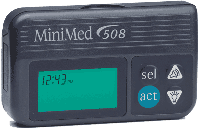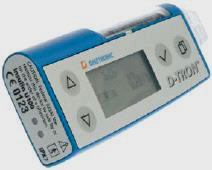This page as a pdf file
What is an insulin pump?
General description of an insulin pump and its use
Photo of a MiniMed 508 pump
An insulin pump is a small device about the same size as a pack of cards, which looks similar to a pager. Inside is a reservoir containing your insulin, which is attached to you via a long piece of thin tubing. At the end of this tubing is a needle or cannula inserted under the skin, enabling the insulin to flow into your body. The pump is not automatic, but is programmed to deliver insulin constantly, at varying rates which you determine. This means that you no longer have to give yourself injections.
The insulin
The pump only contains one type of insulin, the fast-acting sort. This might be Actrapid (Regular), Humulin S (Soluble), Velosulin, Humalog (Lispro), or the new NovoRapid. You do not use any long-acting insulin at all. Instead of taking your insulin at certain times of the day, the pump delivers a constant flow into your body. This has three main advantages:
- You can adjust your insulin spontaneously, since the effect of any changes will be more or less immediate.
- Your body absorbs this type of insulin better than the cloudy, long-acting types. This means that less insulin is wasted, and that the action of the insulin is more predictable.
- The action of the insulin is much smoother and more constant, because a small amount is absorbed every few minutes, rather than a large amount once or twice a day.
Insulin doses
Photo of a Disetronic D-TRON pump
Now for some new terminology. Although you only use one type of insulin, there are two different types of dose: basal and bolus. You may have already heard these terms in connection with MDI, which is also called the basal/bolus regime.
The basal rate takes over the job of your long-acting insulin, i.e. it acts as a background insulin. This takes the form of a constant flow of insulin, just as the pancreas in a non-diabetic provides. You program the rate at which the insulin flows into your body. Older pumps only allowed you to set one rate, but most pumps these days allow you to set a number of different rates. For example, most people need more or less insulin during the night, and many people need more first thing in the morning. Temporary changes can also be made to these rates, for example during a busy day you might need to lower the rate of insulin for a few hours.
The bolus is the insulin you use to counteract the food you eat. Before a meal or snack, you can program the pump to deliver an extra boost of insulin, based on the amount of carbohydrate you are eating. You do not have to take it all at once - for example, if you suddenly decide to have a second helping of pudding, you can then program a bit more. You can even program the pump to give you your bolus over an extended period of time, rather than all at once. This is very useful for dealing with high-fat meals where the blood sugar may rise after several hours.
Increased flexibility
In practice, this all means that you have much more flexibility over your life. You don't have to get up or go to bed at a certain time to take your insulin. You can eat more or less whatever you want, in whatever amounts you want, whenever you want. You don't have to have snacks at certain times.
The Infusion Set
Now to the bit you've been dreading. What's this infusion set? Doesn't it hurt having a needle in you all the time?
Firstly, it doesn't have to be a needle. Infusion sets come in different forms. Some have a short, fine metal needle which you insert under your skin, others have a very fine piece of hollow teflon, known as a cannula. Either way, if it is properly inserted, you can't feel it at all. Every few days, you must remove the needle or cannula and insert a new one in a different spot. Most people use their stomach, but you can also use the hips, thighs, buttocks and arms. If you use the cannula, it is inserted via a hollow needle which fits over it. This is inserted into the skin, the needle is then removed, and the cannula stays in place. Some types of infusion set have an automatic insertion device which fires it into your skin for you (rather like a finger pricker). The end of the infusion set is then taped down to your skin so that it can't become dislodged.
Isn't it a bit awkward having something attached to you all the time?
Well, yes and no. Some people find it takes time to get used to. But after a while, you don't notice it. And most infusion sets are disconnectable. This means that you can detach the tubing from the needle or cannula for short periods. The tubing is sealed so that nothing can get in or out of either piece while it is detached. So you can have a shower, go swimming, get changed, or have sex without having to worry about the pump getting wet or in the way. It's usually OK to disconnect for about an hour, though you may need to take some extra insulin when you reconnect it again.
Wearing the pump
So what do I do with the pump itself? Most people just attach the pump to their belt or waistband using a clip or case, or keep it in their pocket. If this is not convenient, e.g. if you're wearing a dress, there are other options such as attaching it to your arm or leg under your clothes. At night, you can either just put the pump next to you in bed, put it under the pillow, or attach it to your clothing. It will be quite safe, as it can't go anywhere. The pump is very rugged and will resist being dropped on the floor, or the occasional soaking, though it's wise to protect it from such things where possible. Some pumps are even waterproof. For vigorous sports, you may have to devise a safer method of wearing it, or disconnect.
How common are pumps?
The number of people using pumps varies a great deal between countries. In Germany about 1 in 7 people on insulin uses a pump. In the US, it's about 1 in 8. In Britain it's about 1 in 1000. This is largely because of differing opinions amongst healthcare professionals, and differences in healthcare funding policies.
Created: November 1999; Last updated: Tuesday 5 June 2001
Other pages about pumps
[ Funding issues | Pros and cons of pumping | Diabetes UK on pump therapy | Pumps in the Republic of Ireland | What is an insulin pump? | Just like wearing a yoyo | Not controlled, but in control! | Rewriting the diabetes rulebook | To pump or not to pump? | Pumps in pregnancy | Using the insulin pump during pregnancy | Life on a pump | UK pump news | Which pump? | MiniMed | Disetronic | Animas | Books to help with diabetes | Other pump websites | My pump ]
Other pages about infusion sets
[ What is an insulin pump? | Pros and cons of pumping | Wearing a pump | Bad infusion sites and high bgs | Infusion sets | Books to help with diabetes | Using a DiaPort ]


